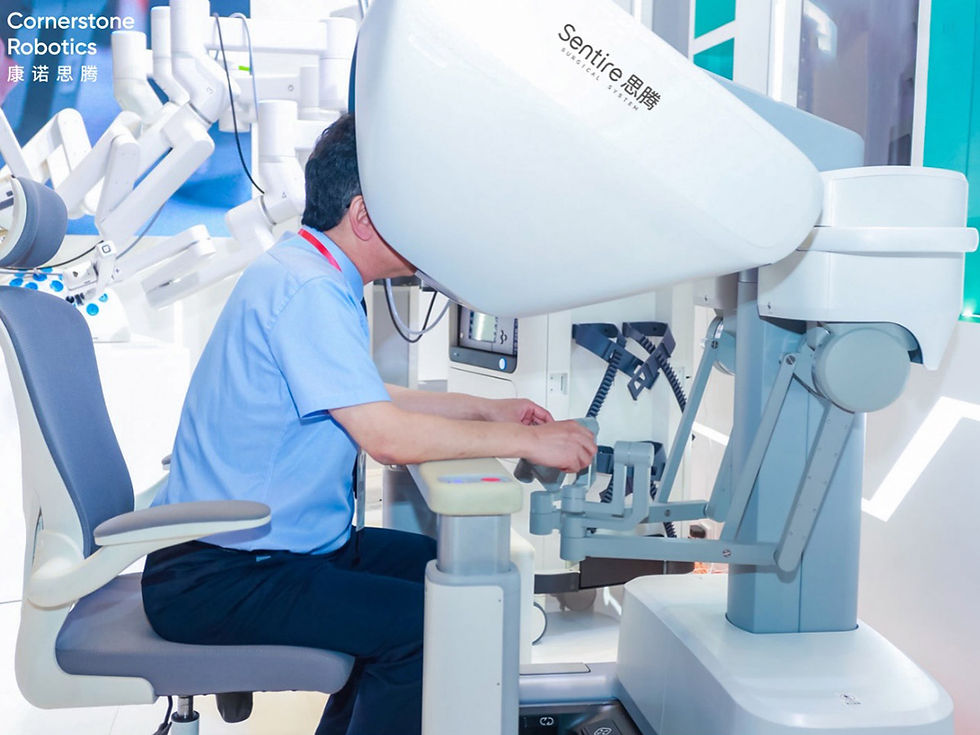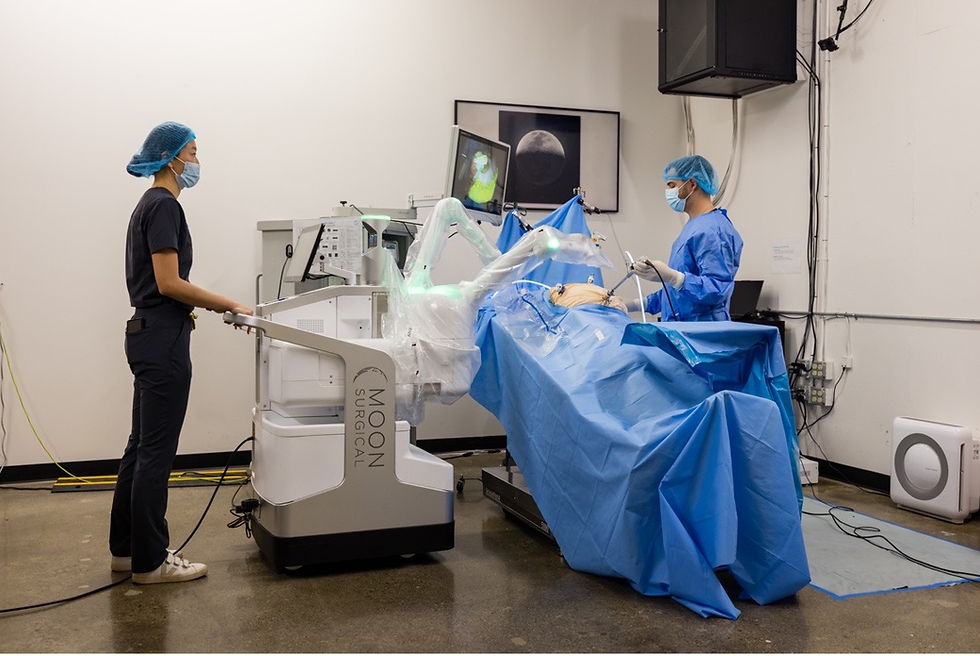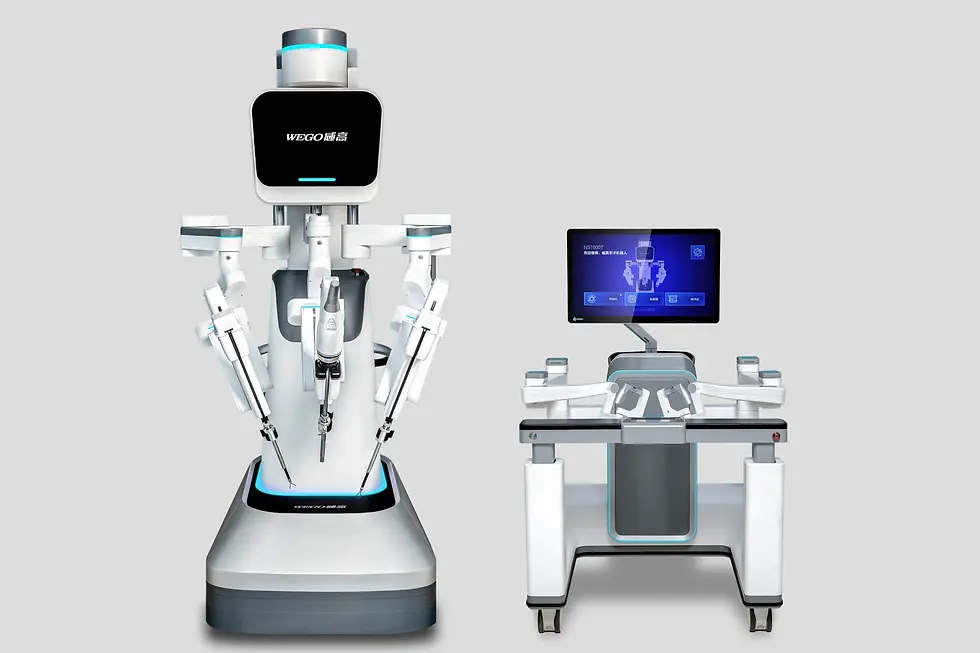Updated: 21 Soft Tissue Surgical Robotics - Multiport systems - list and overview (Systems that compete with daVinci Xi)
- Steve Bell

- Mar 18, 2024
- 14 min read
Updated: Jul 30
So strap in... I'm giving a top level assessment of the 21 current Soft Tissue surgical robots that are competing with the current champion - the daVinci Xi. Most are already doing clinical work, and the others are right on the edge of launch. You may be forgiven if at some point this starts to feel like "Haven't I just seen that one." So let's jump in.
1) Asensus Senhance

Originally from a set of EU Energy department patents, it was originally developed as ALF-X by an Italian Pharma company called SOFAR. It was later bought by the US company Transenterix and morphed into the name of the Senhance system. Later after funding struggles the company worked more towards digital surgery and morphed into Asensus. Senhance has always used the same paradigm - which was to "Digitise" laparoscopic surgery. Using large modular arms - that create a software driven dynamic pivot point. Driven by a "laparoscopic" handled console - which used the same backwards movements (up = down, down = up, left = right, right =left) to mimic laparoscopy. Which as it turns out is not that popular in robotics. People want the "intuitive" style of mapping your hand movements to instrument tips. Senhance has been around a long time but is now winding down as they prepare for their next version of robot (below). Senhance also struggled as it used straight lap style instruments - and an articulated version of some of the instruments came as "too little - too late." (Hint - no one wants articulated instruments - they buy robots for wrists). Nice try at the vision based "helpful" digital surgery but the big size, straight instruments and backwards lap mimicking controls did not make it a fan favourite.
2) Asensus LUNA

In a big leap forwards Asensus have caught up with the pack by bringing out their LUNA system with hopes of re-entering the race. It now follows more the convention of intuitive hand controls that map the hands to the instrument movements. But in another bizarre move they have gone for free floating non haptic linked arm controllers. Almost like Oculus game controllers, the surgeon will operate the system from "untethered" controllers. Controversial for may reasons - the market will decide if back driven haptic based controllers or "free floaters" will be the accepted way. One great feature of LUNA is that they have finally moved away from articulated instruments to fully wristed. With the one twist - they claim to have genuine 5mm instruments (as opposed to 5mm-ish instruments that fit down a "few" special trocars) - they claim real 5mm with full wristed which could be a game changer. Good luck to Asensus as they launch Luna.
3) Avatera Medical -Avatera

Looking much like a cross between a daVinci Si and Xi this electromechanical system hails out of Germany. Like a few of the emerging consoles they have opted for a display mounted binocular immersive vision system. Reports from people that have tried it say that the linear arm configuration rather than an X boom have made it difficult to use in multi quadrants. In a very odd move for a German company... (classically Green) they opted for fully disposable and bipolar instruments. A lot of good reasons "why" as wristed instruments are notoriously difficult to clean and get consistent lives (especially getting them clean to strict German rules is hard). It would be interesting to see how they do... but (and happy to be corrected if wrong) they seem to have ground to a halt... due to funding issues.
I'll say it again, you need $1Bn of investment to survive in this game. And if you look and smell like an Xi you better have some big trick up your sleeve, as without advanced energy, stapling and advanced imaging - there is little to no motivation to switch. Avatera's alleged model of give the hardware and pay for the instruments (as reported) just doesn't not help your cashflow. There is no such thing as a cheap robot - so if you think that is a strategy... it is... but it's a doomed strategy. Let's see if this comes back from the brink.
4) CMR Surgical Versius

Considered the number two best selling soft tissue surgical robot Versius is a cart based modular system with an open console using a 3D screen and passive 3D glasses. It has instruments that will fit through some manufacturers' 5mm ports - but they actually come in at just under 7mm. A few of the unique features of Versius include lack of foot control pedals, and the clever elimination of a Z rail by a universal joint like wrist on the robot arm. The company reached Unicorn status before laying off a large % of its employees as financial difficulties hit. The system is available in a lot of countries based off CE mark and FDA could come in the next years.
5) Cornerstone robotics - Sentire system


The first of the many Chinese Xi clones. It is rather closer to an X than an Xi. Like all the clones it replicates the console of the daVinci with an immersive 3D screen system. They claim in the home market to be a home grown and economically better version of the market leader. No signs of staplers and advanced energy yet, and I imagine if they step out of China then some of the IP of Intuitive may get acted upon. 8mm wristed instruments per standard but other than "cost" there seems to be little advantage to the system.
6) Distal Motion Dexter

A unique approach to the question of robotics - and very focused on keeping the user engaged at the table in the sterile field. A "light" version of a robot with just two instrument arms and a scope holder. The concept is to bring in the 8mm disposable instruments when and as needed. Do a lot lap - and just use the robot for the essential parts of the procedure. Solid Swiss quality abounds but some users say "I buy a robot because I want a robot A-Z in the procedure." The system may appeal to those surgeons that want to stay "in field" but will probably not be chosen by surgeons that consider themselves "Real robotic" surgeons and want everything from the non-sterile console. Mixed feedback so far - but I'm sure the enthusiasts for the hybrid approach will like this way of switching in hybrid procedures.
7) Edge medical MP1000

The next of the Chinese clones. With both a multiport and a single port tower. It honestly looks like a purely re-skinned Xi even with a cross X boom central tower. I do wonder if the IP battles will suddenly erupt if they (and others) set foot out of China? No sign yet of advanced energy or stapling - but it is just a matter of time. Not sure the US hospitals will be queuing up for a Chinese clone anytime soon. But some of the Asian and East Asian markets may be more accepting. It will all come down to economics.
8) Harbin Sagebot Kangduo

Another Chinese clone but with a slight twist. Yes the Xi boom style main operating tower. Yes the 8mm wristed instruments - yes the 3DHD camera - Hang on! I can only count 3 arms! so that is a twist... much like the 3 arm daVinci of years ago that came and went (There's a clue there about 3 arm robots when Intuitive can't make it happen.) And another twist is an open console with 3D screens and passive glasses - which is the emerging trend. So the same yet slightly different.
9) Intuitive dVinci X

Take an Si frame and bolt Xi Z rails to it and - the genius of the X as the entry level model becomes clear. Slightly less capable compared to the Xi - but now allowing the Xi instruments and camera system - whilst still raiding the old parts bin of the Si - this was a genius move by Intuitive and a lot of markets went for it. Think of the cost saving of only one instrument and vision line - yet still able to do trade ins of the old Si and give the same look and feel. I am still never clear if the old Si systems were taken back (bought back as trade ins) to base and recycled and turned into Xs? That for me would have been a super slick move of take it from one customer as a trade in - Frankenstein it - and sell it back out.If they did... I doff my cap.
10) Intuitive daVinci Xi

The king of the boom bots. The original and the best. Loaded to the gills with extraordinary features - instruments - quality - and advanced instruments. Only let down by its aging ICG system, less than stellar 3D HD which compared to many new laparoscopic systems is lowish res - lowish contrast etc. But quality - quality - quality. I do not think unless you've done it and commercialised a robot - you won't understand how low their failure rates are - for the system and the instruments. I personally would not want to be trying to sell a lowered feature clone against this beast. It is the benchmark - period.
11) Intutive da Vinci 5

Game changing next generation of daVinci multiport robots. Massive improvements under the skin and in user interfaces that are designed to improve that all important workflow. Smaller lighter console with new 3D 4K viewer - in head HUD information and control improvements. Soft touch switches and the all important new laparoscopic tower with high flow insufflation and laser built in. Add to that force feedback instruments and easy to upgrade imaging systems and you have a champion for the next decade.
12) Medicaroid - Hinotori

As covered extensively in my PODCAST the Medicaroid Hinotori is a joint venture between Kawasaki heavy industries and Sysmex (a medical company). A boom robot like Intuitive with similar controls - but the similarities end there. Software driven pivot points - no docking to trocars, and like Avatera - a 3D Sony view finder instead of large top heavy screens. It's insanely good Japanese quality - and doing service in multiple centres in Japan. 5G ready and proven for long distance remote surgery. It feels and looks and drives (purposefully like an Xi) but the way it does it is different. The 8DOF arms (1 more DOF than most) helps its anticlash software and helps with multi quadrant even without an X boom. Nice entry from Japan - but will more than the national markets see the desire to switch?
13) Medtronic Hugo RAS

From one of the two big stables in laparoscopy the Hugo is a large form, factor modular robot. Big and stable... but considered too big by many. Open console with 3D HD Storz last generation imaging. Up to 4 active arms, scope swapping available and a base range of fully wristed 8mm instruments. Awaiting Ligasure and Stapling to really be able to compete. But hey... it's Medtronic so they know how to do lap - know how to train - know stapling and energy. Regulatory cleared across a lot of the world and active in an FDA IDE. Mixed feedback with some saying it adds little to the Xi - while others feel the modularity does bring some customisation to the party. Add in their intelligent video system Touch and ability to bundle across their offering - and Medtronic is one to watch. (But it needs to be smaller and lighter to compete with the other and coming modular units.)
14) Mere company Revo -I

Korea's flat out X clone is well... an X clone. Been out for a while but hit early on with reliability issues that knocked it in the market. Limited success outside of Korea and reportedly feels more like an Si in many ways than an X. Feels a bit dated. Again why have a 2005 BMW model 3 when I can have the BMW 2024 mode 5l? Seems a stretch - but like all the clones there will be some fans that want to be different and do some papers.
15) Microport (MedBot) Toumai

Are these clones all feeling very familiar yet? Microprt Toumai is their Xi clone and well.. it is very much like an Xi except it doesn't have all the bells and whistles such as advanced energy and stapling. It does have fully wristed 8mm instruments - and their own in house 3D HD laparoscope / imaging technology. It's all just very much a clone. One thing to make note though is that Microprt is not just a China based - China only company. They are actually pretty serious med device company with a decent worldwide footprint - which makes this one to watch as they do know what they are doing with commercialisation.
16) Moon Surgical Maestro

Finally something a bit different that looks nothing like a DaVinci Xi. And well... it's because it is an entirely different approach to surgical robotics. Technically it's not in the same category as an Xi as it's really a robotic assisted laparoscopy product. The idea is that it allows a single surgeon to do solo surgery. The Maestro hold the camera in one arm and a retractor instrument in another. Removing the need for a surgical assistant (Theoretically). What Maestro also does - is for any to the arms attached to a retracting graspers - let's say - it feels the released force and then can keep that force constant - by a bit of clever force sensing - so you can keep excellent tissue counter traction as you develop your primary dissection. Pretty cool. You can use it with any camera system and any lap instruments - BUT you don't get wristed and you don't get an ergonomic console.
17) Ronovo Carina


So Ronovo has taken a the z-rail technology and instrument design that has been seen on a few systems. Including VERB, which is obvious as a lot of the team came from Verb. The arms are small and compact and really what Hugo needed to be. They are smaller like a Versius cart -- BUT the Z rail can lead to a crowded surgical field - limits on trocar placement and possible clash. The remote centre mechanism has some upsides and downsides.
Console wise it looks a bit like a closed cockpit à la daVinci - so it's sort of a hybrid. If you note well it has 5 small drive wheels on its instrument interface - which indicates advanced instruments such as staple drive mechanisms on the way. Nice - small - compact - and one to watch. (But do note the set up above has big spaces between trocars -- dunk dunk?)
18) Robsurgical Bitrack


Spain has an entry to the Eurovision... with Robsurgical and their Bitrack. Very very big mainframe with three arms (oops gonna have issues there again). Interestingly they don't have terminal Z-rails like a daVinci but have motor drives that hang - like a Senhance. They have claims of adaptive virtual pivot points... but that's not exclusive - several others above that don't use remote centre have that. Open screen 3D HD and 8mm wristed instruments. All versions of the above and below blended together into this Spanish company born from a Spanish University project. Claims of super fast set up and portability (an odd one claiming that one massive beam is more more portable than 6 small modules -- well it's just such an odd claim. Have they tried to get it into a standard lift/ elevator yet?)) Fast draping is also claimed in sub 30 seconds. Which is possible if you only drape the terminal joint. But I'm wondering how that will pass US standards? Good effort from Spain but I think this is potentially another Senhance - let's see.
19) Sinamed sinaflex

Now we move to a little known but interesting Iranian surgical robot. Sinamed has brought out a two instrument arm robot called SinaFlex. Which I assume got its name because interestingly it doesn't have wristed instruments - but instead flexible instruments. The other main thing about this system is that it is bed mounted. So modular but mounted on the bed - much like historically the Aesop system. And the soon to come Ottava. Again as in previous posts I've learned that bed mounted causes all kinds of issues - and the fact it is only two arms and a distance scope holder tells me that yet again clash for bed mounted systems (Aesop, DLR, and other attempts) is an issue. The second issue is that moving patients around using "integrated table motion" is potentially a bad idea. Well bad if you keep your instruments in the patient!! If the patient moves slightly the pivot point moves and you get alarms. If the patient were to slip while the table is being moved and a scissor is hanging just over the aorta -- well that would not be good. Hence instruments need to be removed before table adjustments are made in reality. (you might, if you're lucky, get away with the pivot point being in the same place.)
The console is an open console and much like Versius you can sit or stand at it for best ergonomics. It's an interesting attempt - but for me... clumsy deign means a lot of weight is suspended from the table and swinging about above the patient. I think it will be limited to the home market of Iran and maybe some Middle Eastern markets.
20) SSInnovations Mantra

India's home grown "budget" robot is on its third generation. The first had too many user issues - this second was too thin, tall and unstable - but the third is in good solid usage with good feedback. It has a very large range of instruments - 8mm and wristed. It uses a Senhance like big cart structure but with Z rails on the end. Clash is a potential issue but users so far don't seem to be too concerned. It is big and it occupies most of the surgical field. Good 3D open console and nice hand controllers. It is said to be selling at $300K in India - which is 30% of a daVinci. So a major saving if true - that could entice a lot of institutions to try. One really interesting feature is that nit was designed (invented and founded) by a cardiac surgeon. So while every other robot is backing away from cardiac surgery - they are going all in as one of their specialties. A bold and probably clever move to set them apart. I'm not sure how well it will be received in Europe and USA but in India it is said to be taking significant market share. And as it is being used in India watch the case load jump up quickly which will help populate their digital ecosystem. The vision system is interestingly a 4K scope with a flexible end tip - and that also sets it apart from most other robots. Expect ICG soon and I think we will hear more from SSi.
21) WEGO - Microhand


Wego has brought out.. yep you guessed it... another three arm DaVinci clone - but with an open console and 3D screen. Remote centre and 8mm wristed instruments. So very much like the other China clones of a daVinci. Again no X boom so multi quadrant will be a challenge even though this does have a swivelling boom so maybe they will get some advantages over an Si style frame. It all feels very much a copy product with some slight changes and I imagine it will be another robot for the large China market. But I imagine that should it set foot out of China - it will face challenges - as they all would. IP? Maybe - but just general image of buying a Chinese clone when you can get the daVinci which is fully loaded.
Summary
So that's it folks. The market is dividing in a few ways:
Open screen consoles vs periscope views
Single boom robots vs modular robots
3 arms vs 4 arms
Innovation features vs clones (Tried and tested)
I think over the coming years many of these clones will meet the dawning reality of what they are up against and slowly those companies will abandon the chase. I also think for the modular robots - carts will win - but only small and light carts. Overhead boom carts and table mounted will learn the painful lesson of the past. Let's see what the next five years hold and let's see if daVinci crushes it with Gen 5. I predict there will be only 2 or 3 from this list still alive (in any meaningful way) in the next 5 years.






Comments